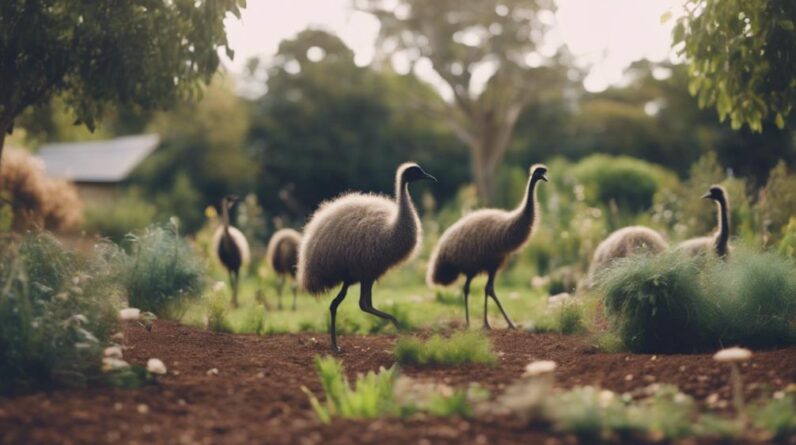
You might be wondering how emus could possibly play a significant role in permaculture designs. However, these fascinating creatures offer a range of benefits that can enhance the sustainability and productivity of your permaculture system.
From their unique grazing patterns to their contribution to nutrient cycling, emus have the potential to positively impact various aspects of your permaculture design. By exploring their role in more detail, you will uncover valuable insights that could transform the way you approach sustainable agriculture practices.
Key Takeaways
- Emus contribute to pest control and soil fertility in permaculture systems.
- Their grazing patterns aid in ecosystem health and erosion prevention.
- Emu dung enriches compost mixes and improves soil structure.
- Leveraging Emu behavior enhances water conservation and climate resilience.
Pest Control Benefits
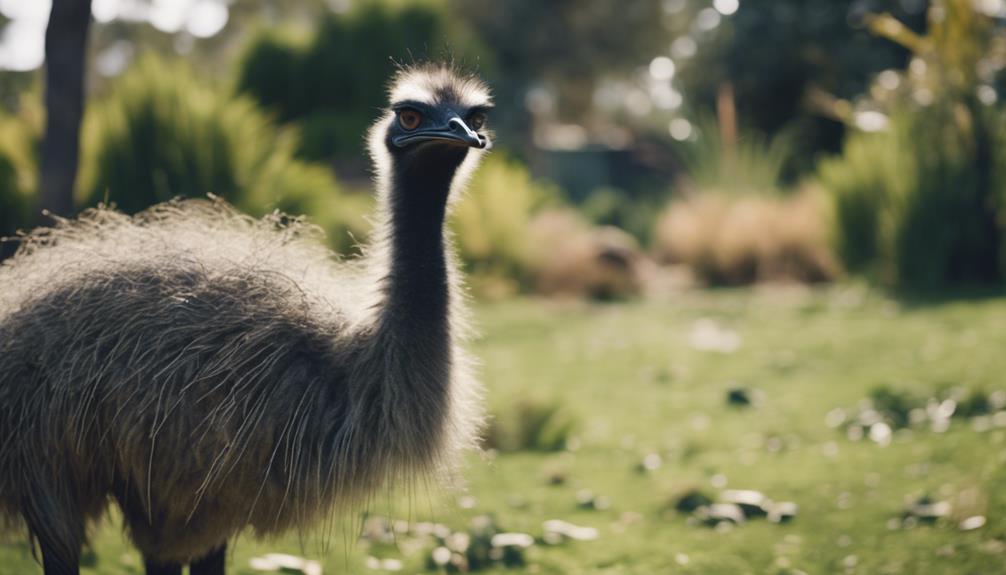
Have you ever considered how emus can revolutionize pest control in permaculture designs? These majestic birds serve as natural predators, offering a sustainable solution for managing pests in your permaculture system. Emus play a crucial role in biological control by preying on insects and small rodents that can harm your crops. By introducing emus into your permaculture design, you can create a balanced ecosystem where these birds help maintain the pest population at bay, reducing the need for harmful chemical pesticides.
Emus aren't only efficient pest controllers but also contribute to the overall health of your permaculture garden. Their presence encourages a more natural and harmonious environment, where the ecosystem functions in a self-regulated manner. Emus add a layer of biodiversity that enhances the resilience of your permaculture system, promoting a more sustainable and ecologically friendly approach to pest management. Embrace these feathered friends in your permaculture design and witness the positive impact they can have on your garden's well-being.
Soil Fertility Improvement
Enhance the fertility of your soil through innovative and eco-conscious practices that promote sustainability in your permaculture design. To enrich your soil, focus on composting methods that boost microbial activity. Composting kitchen scraps, yard waste, and emu manure creates nutrient-rich humus, enhancing soil structure and increasing organic matter content.
Consider vermicomposting as well, using worms to break down organic materials into potent fertilizers. This process not only improves soil fertility but also reduces waste sent to landfills. Emus can play a role in this too, as their manure is a valuable addition to the composting mix.
Weed Management Solutions

To effectively manage weeds in your permaculture design, integrate natural mulching techniques that suppress weed growth while nourishing the soil. Natural predators and animal impact can play a crucial role in keeping weed populations in check while promoting a healthy ecosystem.
Here are some practical and innovative solutions to help you manage weeds sustainably:
- Cover Crops: Planting cover crops like clover or buckwheat can outcompete weeds for resources, acting as a living mulch that suppresses unwanted plants.
- Mulching: Use organic materials such as straw, wood chips, or leaves to cover the soil, smothering weeds and providing nutrients as they decompose.
- Companion Planting: Pairing compatible plants together can help deter weeds by creating a dense canopy that shades the soil and limits weed growth.
- Integrate Livestock: Grazing animals like goats or chickens can help control weeds by eating them, while also adding manure to the soil, enriching its fertility.
Grazing Patterns and Rotation
Incorporating grazing patterns and rotation strategies into your permaculture design can optimize land use efficiency while promoting soil health and biodiversity. Rotational grazing involves dividing your land into smaller paddocks where emus graze for a specific period before moving to the next. This method not only prevents overgrazing but also allows vegetation time to recover, enhancing its nutritional value for the emus. By practicing rotational grazing, you can mimic the natural movement patterns of wildlife, stimulating plant growth and soil vitality.
Forage management is another crucial aspect to consider when designing your emu grazing system. Ensuring a diverse range of forage options won't only meet the nutritional needs of the emus but also support a healthy ecosystem. Planting a mix of perennial grasses, legumes, and herbs can provide a balanced diet for the emus while improving soil structure and fertility. Strategic forage management contributes to sustainable land stewardship, enhancing the resilience of your permaculture design.
Nutrient Cycling Mechanisms
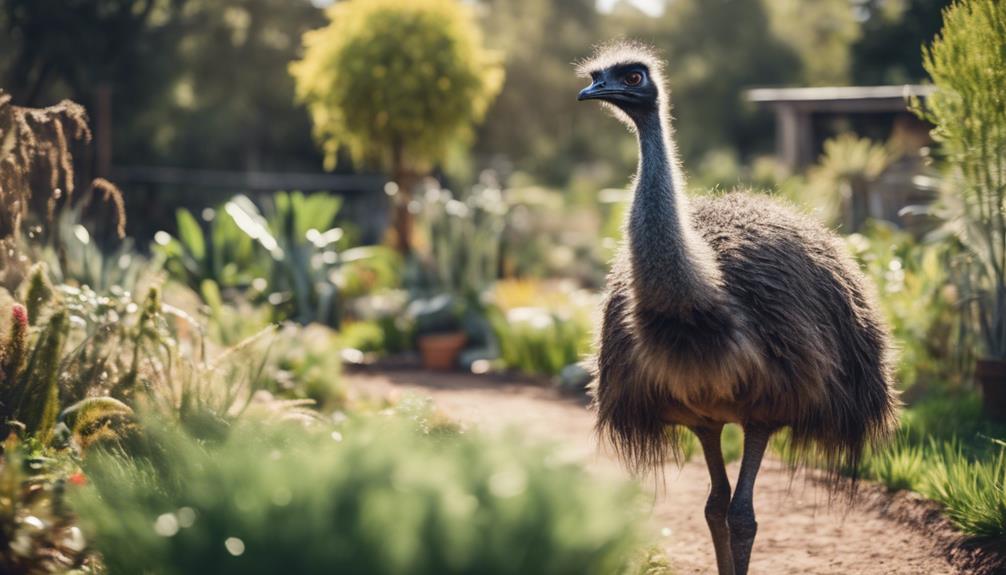
Utilizing organic matter and biological processes in your permaculture system fosters efficient nutrient cycling mechanisms essential for sustaining soil fertility and ecosystem health. Emu dung, a rich source of nitrogen and phosphorus, can be utilized as a potent fertilizer to enhance soil fertility. The unique composition of emu dung aids in improving soil structure, water retention, and microbial activity, thereby promoting healthy plant growth and biodiversity.
Benefits of Emu Dung as Fertilizer:
- Nutrient-Rich: Emu dung contains high levels of nitrogen and phosphorus, essential for plant growth.
- Soil Conditioning: Its organic matter content helps improve soil structure and water retention.
- Microbial Activity: Encourages beneficial microbial populations, enhancing nutrient availability for plants.
- Sustainable: Using emu dung as fertilizer aligns with eco-conscious practices, reducing the need for synthetic inputs and promoting a closed-loop nutrient cycle.
Incorporating emu dung into your permaculture design not only enriches the soil but also contributes to the overall health and sustainability of your ecosystem.
Erosion Prevention Strategies
Enhancing soil stability and promoting long-term sustainability in your permaculture system involves implementing effective erosion prevention strategies. Mulch application is a simple yet powerful technique that can significantly reduce soil erosion. By covering the soil with organic materials like straw, leaves, or wood chips, you not only protect it from the impact of heavy rain and wind but also improve moisture retention and soil fertility.
Contour plowing is another essential method to prevent erosion in your permaculture design. By plowing along the contour lines of the land instead of up and down slopes, you create natural barriers that slow down water runoff, allowing it to infiltrate the soil slowly. This helps to prevent soil loss and nutrient depletion while promoting the healthy growth of your plants.
Integrating mulch application and contour plowing into your permaculture system can enhance soil health, conserve water, and minimize erosion, ultimately leading to a more sustainable and resilient ecosystem. Embrace these strategies to create a thriving environment where your plants can flourish harmoniously.
Biodiversity Enhancement Effects
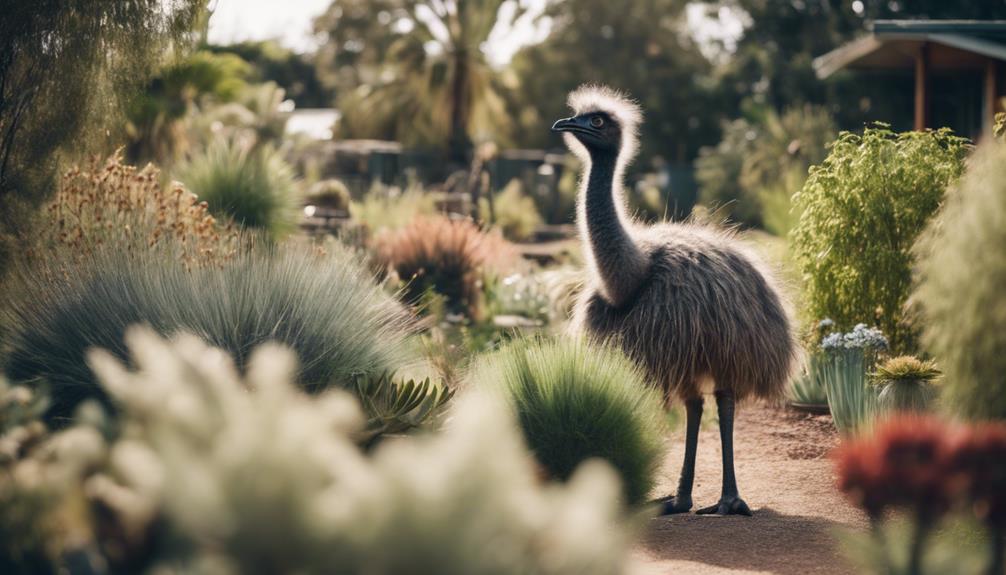
To promote a thriving ecosystem in your permaculture design, consider how biodiversity enhancement can positively impact the health and resilience of your plants. Emus play a crucial role in enhancing biodiversity within your permaculture system. Here's how:
- Ecological Balance: By foraging on a variety of plants, emus help maintain a balanced ecosystem by preventing the dominance of certain plant species. This leads to a healthier and more diverse plant community.
- Habitat Restoration: Emus aid in habitat restoration by dispersing seeds through their droppings, helping to regenerate native vegetation and restore degraded areas.
- Natural Pest Control: Emus consume insects and small animals, naturally controlling pest populations in your permaculture design without the need for harmful chemicals.
- Soil Health: Emus' grazing and movement patterns can help aerate the soil, improve its structure, and increase nutrient cycling, contributing to overall soil health and plant vitality.
Embracing emus in your permaculture design can significantly enhance biodiversity, promoting ecological balance and habitat restoration for a more resilient and sustainable system.
Water Conservation Practices
Considering the vital role water plays in sustaining life within your permaculture design, implementing efficient water conservation practices is essential for maintaining a thriving and sustainable ecosystem.
Embrace rainwater harvesting as a means to capture precious water straight from the sky, reducing your reliance on external sources.
Utilize greywater recycling to repurpose wastewater from sinks, showers, and laundry for irrigation, minimizing water wastage and nourishing your plants.
Integrate drip irrigation systems to deliver water directly to the roots, reducing evaporation and ensuring efficient water usage.
Construct swales, which are shallow ditches along contours, to slow down and retain rainwater, allowing it to percolate into the soil and recharge groundwater levels.
Climate Resilience Considerations
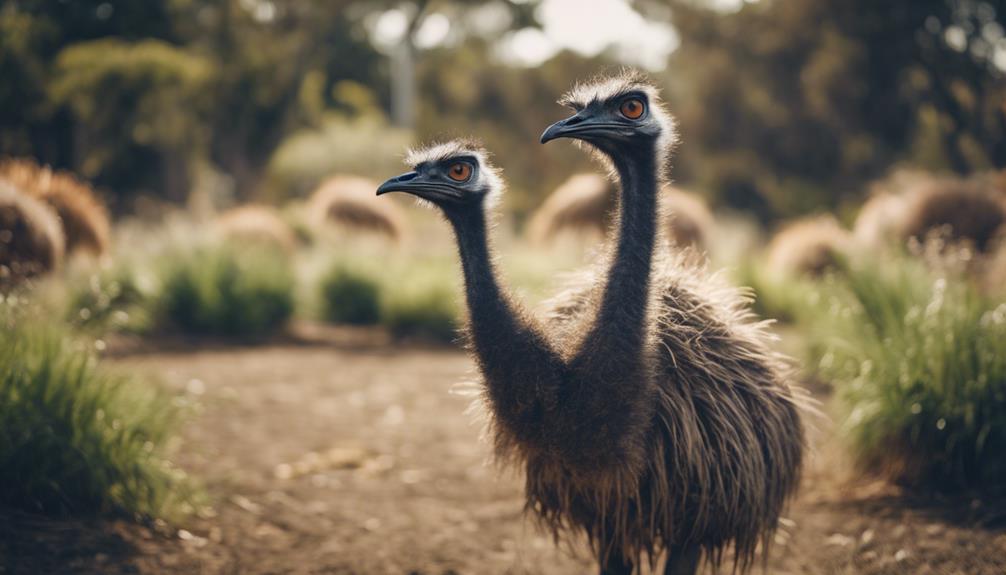
Embracing adaptive strategies is crucial for fortifying your permaculture design against the unpredictable challenges posed by a changing climate. To enhance climate resilience in your permaculture system, consider the following:
- Leverage Emu Behavior: Emus play a vital role in maintaining ecosystem balance through their foraging habits. Encouraging emu presence can help control pests and promote biodiversity, contributing to overall resilience.
- Implement Land Regeneration Techniques: Utilize regenerative practices like rotational grazing and keyline plowing to improve soil health and water retention. Healthy soil is fundamental for withstanding climate fluctuations.
- Diversify Plant Species: Integrate a variety of native plants into your design to create a robust ecosystem that can adapt to changing conditions. Diversity enhances stability and resilience.
- Observe Climate Patterns: Stay attuned to local climate trends and adjust your permaculture strategies accordingly. Flexibility and continuous observation are key to effectively addressing climate challenges in your design.
Companion Planting Opportunities
Enhance your permaculture design's sustainability by exploring Companion Planting Opportunities that optimize plant relationships for mutual benefit. Companion planting is not just about maximizing space but also about fostering connections that benefit the overall health of your garden. By strategically planting different species together, you can improve soil health through nutrient cycling, pest control, and beneficial microorganism support.
Consider creating diverse plant communities within your food forests to mimic natural ecosystems. This approach can enhance resilience and productivity while reducing the need for external inputs. Here is a table illustrating some beneficial plant companionships for soil health and food forests:
| Plant 1 | Plant 2 | Benefits |
|---|---|---|
| Legumes | Corn | Fix nitrogen in the soil |
| Nasturtium | Cucumbers | Repel pests |
| Marigolds | Tomatoes | Suppress nematodes |
| Comfrey | Fruit trees | Dynamic accumulator |
Integrating these companion planting strategies can lead to healthier plants, increased biodiversity, and a more resilient ecosystem within your permaculture design.
Integrated Pest Management Approaches

To mitigate pest issues effectively in your permaculture design, implement integrated pest management approaches that prioritize ecological balance and minimal environmental impact. By incorporating these strategies, you can create a harmonious ecosystem where pests are managed naturally, reducing the need for harmful chemicals.
Integrated Pest Management Approaches:
- Biological Controls: Introduce beneficial insects like ladybugs or parasitic wasps to combat pest populations organically.
- Natural Predators: Encourage the presence of animals such as birds, frogs, or spiders that feed on pests, helping to maintain a balanced ecosystem.
- Crop Rotation: Alternate plant families in different areas each season to disrupt pest life cycles and reduce infestations.
- Cover Crops: Planting cover crops like clover or rye can suppress weed growth, attract beneficial insects, and improve soil health, contributing to pest management in a sustainable manner.
Design Integration Techniques
By implementing innovative design integration techniques in your permaculture system, you can optimize space utilization and foster a more resilient and sustainable ecosystem. When considering composting methods, think about incorporating worm composting bins directly into your garden beds. This not only recycles organic waste but also provides a natural source of fertilizer for your plants, creating a self-sustaining cycle within your permaculture design.
For habitat restoration, consider creating diverse microclimates within your space by strategically placing trees, shrubs, and other vegetation. This will attract beneficial wildlife, such as pollinators and pest predators, enhancing the overall health of your ecosystem. Additionally, utilizing vertical gardening techniques, like trellises or living walls, can maximize growing area while adding aesthetic appeal to your permaculture design.
Frequently Asked Questions
How Can Emus Be Integrated Into Permaculture Designs to Enhance the Aesthetic Appeal of the Landscape?
To enhance your landscape, consider integrating emus for their companionship and natural abilities to enrich the environment. Emus can help create a harmonious, sustainable permaculture design that not only looks beautiful but also thrives.
Are There Any Specific Challenges or Drawbacks to Using Emus for Pest Control in Permaculture Systems?
Navigating the realm of using emus for pest control in permaculture systems poses both challenges and benefits. Embrace the hurdles with innovative solutions, balancing drawbacks with the eco-friendly advantages these unique birds bring to your landscape.
What Are Some Alternative Grazing Animals That Can Be Used in Conjunction With Emus to Maximize the Benefits of Nutrient Cycling?
You can enhance soil fertility and ecosystem balance by combining emus with alternative grazing animals like goats or sheep. Utilize rotational grazing to optimize nutrient cycling, pest management, and landscape enhancement while adhering to urban regulations and residential guidelines.
How Do Emus Impact the Overall Wildlife Population and Ecosystem Balance in a Permaculture Design?
In permaculture designs, emus' impact on the ecosystem balance is profound. Their presence influences the wildlife population, fostering a harmonious environment. Emus efficiently contribute to nutrient cycling, enhancing sustainability and biodiversity in your permaculture system.
Are There Any Specific Regulations or Guidelines to Consider When Incorporating Emus Into Permaculture Designs, Especially in Urban or Residential Settings?
When incorporating emus into permaculture designs in urban or residential settings, it's crucial to follow regulations and guidelines. Consider their space needs, food sources, and interactions with other wildlife. Embrace these majestic creatures mindfully for a harmonious ecosystem.
Conclusion
In conclusion, incorporating emus into permaculture designs can greatly benefit your sustainable practices. These unique birds offer natural pest control, improve soil fertility, and aid in weed management. By integrating emus into your system, you can enhance nutrient cycling, increase climate resilience, and promote companion planting.
Emus are like the missing puzzle piece in your permaculture design, helping to create a harmonious and balanced ecosystem. So why not let these majestic birds be your eco-friendly allies in your quest for a thriving garden?





